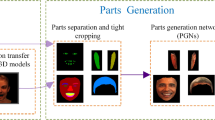Abstract
This paper proposes a new algorithm, called Edge-based Texture Driven Shape Model (E-TDSM), for non-frontal face alignment task. First, the texture is defined as the un-warped edge image contained in the shape rectangle; then, a Bayesian network is constructed to describe the relationship between the shape and texture models; finally, Expectation-Maximization (EM) approach is utilized to infer the optimal texture and position parameters from the observed shape and texture information. Compared with the traditional shape localization algorithms, E-TDSM has the following advantages: 1) the un-warped edge-based texture can better predict the shape and is more robust to the illumination and expression variation than the conventional warped gray-level based texture; 2) the presented Bayesian network indicates the logic structure of the face alignment task; and 3) the mutually enhanced shape and texture observations are integrated to infer the optimal parameters of the proposed Bayesian network using EM approach. The extensive experiments on non-frontal face alignment task demonstrate the effectiveness and robustness of the proposed E-TDSM algorithm.
Similar content being viewed by others
References
Romdhani S, Blanz V, Vetter T. Face identification by fitting a 3D Morphable model using linear shape and texture error functions. In Proc. 7th European Conf. Computer Vision., Copenhagen, Denmark, May 27–June 2, 2002, pp.3–19.
Li Y, Gong S, Liddell H. Modeling faces dynamically across views and over time. In Proc. 8th IEEE Int. Conf. Computer Vision, Vancouver, Canada, July 9–12, 2001, pp.554–559.
Lanitis A, Taylor C J, Cootes T F. Automatic interpretation and coding of face images using flexible models. IEEE Trans. Pattern Analysis and Machine Intelligence, 1997, 19(7): 743–756.
Moghaddam B, Pentland A. Probabilistic visual learning for object representation. IEEE Trans. Pattern Analysis and Machine Intelligence, 1997, 19(7): 696–710.
Cootes T F, Taylor C J. Statistical models of appearance for computer vision. Technical Report, University of Manchester, 2001.
van Ginneken B, Frangi A F, Staal J J et al. A non-linear gray-level appearance model improves active shape model segmentation. In Proc. 5th IEEE Workshop on Mathematical Models in Biomedical Analysis, Kauai, Hawaii, USA, Dec. 9–10, 2001, pp.205–212.
Mitchell S C, Lelieveldt B, Geest R van der et al. Segmentation of cardiac MR images: An active appearance model approach. In Proc. Key to the Future, Leiden International Medical Students Congress, Nov. 26–27, Nederlanders, 1999, p.52.
Yan S C, Liu C, Li S Z et al. Texture-constrained active shape models. In Proc. 1st Int. Workshop on Generative-Model Based Vision in Conjunction with European Conf. Computer Vision 2002, Copenhagen, Denmark, June 2, 2002, pp.107–113.
Bilms J. A gentle tutorial of the EM algorithm and its application to parameter estimation for Gaussian mixture and hidden Markov models. ICSI-TR-97-021, UC. Berkeley, Apr. 1998.
Jolliffe I T. Principal Component Analysis. Springer-Verlag, 1986.
Cootes T F, Edwards, Taylor C J. Active appearance models. In Proc. 5th European Conference on Computer Vision, Freiburg, Germany, June 2–6, 1998, 2: 484–498.
Kent J T, Mardia K V. Shape, procrustes tangent projections and bilateral symmetry. Biometrika, 2001, 88(2): 469–485.
Yan S C, Li M J, Zhang H J, Cheng Q S. Ranking prior likelihood distributions for Bayesian shape localization framework. In Proc. 9th IEEE International Conference on Computer Vision, Nice, France, Oct. 13–16, 2003, 1: 51–58.
Author information
Authors and Affiliations
Corresponding author
Additional information
Supported by the National Natural Science Foundation of China under Grant No. 10471002 and the National Basic Research 973 Program of China under Grant No. G1999075105.
Rights and permissions
About this article
Cite this article
Li, H., Yan, SC. & Peng, LZ. Robust Non-Frontal Face Alignment with Edge Based Texture. J Comput Sci Technol 20, 849–854 (2005). https://doi.org/10.1007/s11390-005-0849-8
Received:
Revised:
Issue Date:
DOI: https://doi.org/10.1007/s11390-005-0849-8




